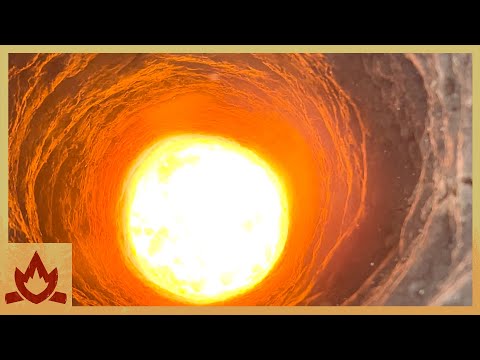Primitive Technology: Natural Draft Iron Smelt

The natural draft furnace will be built at the hut where the charcoal is stored A pit 25 cm wide and 25 cm deep is dug Water is added to make mud Part of an old furnace wall is crushed to make mud Forming the furnace wall Furnace is 25 cm internal diameter with walls 12.5 cm thick Layers are added when the previous ones dry The furnace height slowly rises 25 cm per day, to ensure the mud doesn't slump 4 opposing air entries are added A door is cut into the front from where the iron will be retrieved More furnace height is added Furnace is 1.5 m tall above the air entries, taking 7 days to build in dry weather wood is collected to fire dry the furnace A small fire is lit in the doorway to slowly dry the mud The strong draft is evident from the roaring sound The next day the furnace is dry Making the tuyeres or air pipes from clay A 20 cm square is made It is then rolled onto a dusted log to form the tube The tube is lifted upright and the log removed, leaving it to dry in place 4 tuyeres, 5 cm diameter and 20 cm long Installing tuyeres Plastering gaps with mud 3 tuyeres in place The door is then closed with mud while installing the 4th tuyere All the tuyeres are installed Cracks need to be sealed with clay slip to prevent short circuiting the draft between the air inlet and outlet The creek where iron ore (iron bacteria) is collected Iron bacteria lives in water with soluble iron from rocks and minerals The bacteria converts soluble iron 2 oxide in water to iron 3 oxide precipitate The dilute iron oxide is collected in a pot It then settles in a porous pot where the water seeps out retaining the iron oxide The iron oxide forms a paste which is then dried The ore is then broken up and put in a pot to be smelted later Charcoal is made by stacking the kiln with wood The wood at the top of the kiln is coated in mud leaving a hole in the top for draft Hot coals are put in the top hole The fire burns back down against the draft towards the air entries, carbonizing the wood When the fire has reached the air entries, they are sealed with mud Then the exit flue is sealed The next day the top is broken open The wood has mostly converted to charcoal, any unburnt wood is saved for next time Charcoal is taken from the workshop to the brick hut where it is stored 9 pots of charcoal For the preheat, the furnace is stacked with thin pieces of wood first so it won't break the tuyeres as they fall down the chimney Heavier wood can now be added, their fall cushioned by the sticks Furnace full of wood Making fire with fire sticks The fire is allowed to burn back down against the draft, preheating the furnace. It makes less smoke this way Cracks appear and are sealed with clay slip. This is important when using natural draft as an air supply, as the cracks can short circuit the draft When fire reaches the tuyeres, charcoal is added 3 double handfuls of charcoal is added per charge 5 charges of charcoal are added 2 single handfuls are then added Now 3 double handfuls of charcoal and 2 single handfuls of ore are added per charge about 5 minutes apart 11 charges of ore were made over an hour A blob of slag can be seen at the top of the tuyere, pieces of ore fall onto it and get absorbed About an hour later, flames can be seen from the top Now viscous slag can be seen pouring through the coals The next day, the door is opened Slag has adhered to the tuyeres and the furnace walls have vitrified The product is taken out for processing Small droplets of iron metal can be found in the slag A piece of iron The brittle slag is crushed to get the iron pieces out The iron is harder to break than the slag which makes it easy to identify The crushed slag is kept for further processing Another piece of iron in the slag The iron picked out by hand The crushed slag is then panned in water to separate out more iron via gravity separation More iron The slag is set aside along with slag from previous smelts This will be re-smelted to see if there's any more iron left in it 4 g of iron was made, proof of concept for natural draft iron smelting works The old tuyeres are dug out 8 tuyeres will be installed this time The 4 tuyere ports are enlarged to accept 2 per port Now double the air is focused into the center of the furnace Again the tuyeres are sealed in place The furnace is filled with wood as before Roof tiles are put in place to keep the rain out till the day of the smelt The slag from previous smelts will be used as ore this time Fire by friction Fire is lit from the top and burns down preheating furnace Very little smoke is produced this way Again, natural draft furnaces must have their cracks sealed with clay to work well Again 3 double handfuls of charcoal per charge 9 charges of charcoal added 3 single handfuls of slag, 3 double handfuls of charcoal per charge This time the furnace is kept half full to see if it draws a stronger draft The slag flows more freely now, probably because of the greater airflow from the tuyeres Checking the height of the fuel bed 13 charges were added in total I came back later and the slag had become stuck in the furnace So I opened the front door The furnace was very clogged with slag So the slag was dislodged with a stick from below and above Then the furnace started drawing a draft again The next day Material is pulled out for processing This time only a gram of iron was made due to the clogged furnace, I added too much slag per charge Having smelted this slag twice, it is thrown out as there won't be much iron left in it now The iron from the 2 smelts are combined 5 grams of iron, proof that natural draft can be used to smelt iron More experimenting needs to be done to improve yields but it's a start
2023-12-02 16:08


